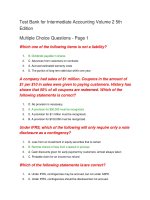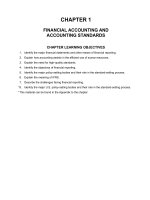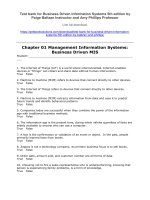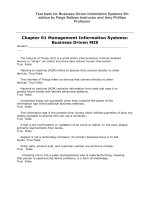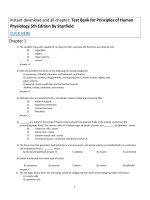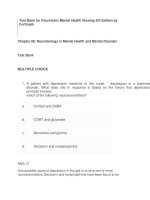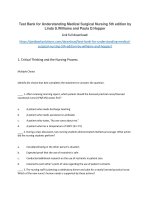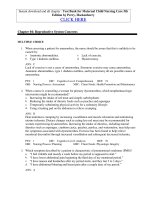Test bank for intermediate accounting volume 2 5th edition by beechy
Bạn đang xem bản rút gọn của tài liệu. Xem và tải ngay bản đầy đủ của tài liệu tại đây (222.72 KB, 30 trang )
Test Bank for Intermediate Accounting Volume 2 5th Edition by
Beechy
Conceptually, liabilities constitute a present obligation as a result of a past
event.
1. True
2. False
Under IFRS, only legal obligations are recognized.
1. True
2. False
A reasonable expectation on the part of a company's stakeholders arising from a
company's past practices or behaviour may constitute a constructive obligation
in certain instances.
1. True
2. False
A contingency may become a provision if the likelihood of the contingent event
greatly increases.
1. True
2. False
For a small population, the best estimate for the amount of a provision that must
be recognized is the expected value of the possible outcomes.
1. True
2. False
For a large population, the best estimate for the amount of a provision that must
be recognized is the most likely outcome with respect to the expected value and
cumulative probabilities.
1. True
2. False
Discounting is not required when the time value of money is immaterial or if the
amount and timing of cash flows is highly uncertain.
1. True
2. False
For a small population, the best estimate for the amount of a provision that must
be recognized is the expected value of the possible outcomes.
1. True
2. False
Contingencies must be both accrued and disclosed.
1. True
2. False
Under proposed changes to current standards, amounts currently classified as
contingencies may need to be accrued rather than simply disclosed.
1. True
2. False
An onerous contract is one where the unavoidable costs of meeting the contract
may or may not exceed the benefits derived from the contract.
1. True
2. False
A lawsuit in progress wherein the defendant will probably be found guilty would
likely be accounted for as a provision.
1. True
2. False
Warranties provisions may arise from legal or constructive obligations.
1. True
2. False
Once a company has formally decided to restructure its operations, a provision
must be made for the restructuring.
1. True
2. False
Loyalty points are provided (accrued) for and reversed once the points are
redeemed.
1. True
2. False
Self-insurance costs for expected losses must never be provided for.
1. True
2. False
Current liabilities are usually discounted.
1. True
2. False
The carrying value of a bond from the issuing corporation's standpoint will
always move closer to its face value, regardless of whether the bond is issued at
a premium or a discount.
1. True
2. False
Under the effective interest method, interest expense is calculated by
multiplying the market interest rate by the carrying value of the bonds.
1. True
2. False
Assume that a company issues bonds at a discount. Under the effective interest
method, the company will record progressively less interest with the passage of
time.
1. True
2. False
Transaction costs are usually included in the carrying value of any financial
liabilities.
1. True
2. False
Long-term financial liabilities will usually be carried at amortized cost.
1. True
2. False
Adjustments to fair value relating to FVTPL liabilities will always flow through
earnings.
1. True
2. False
Loan guarantees must be provided for; the amount of the provision is the
probability of payout multiplied by the fair value o the loan guarantee.
1. True
2. False
When the market rate exceeds the stated or nominal rate, a bond's carrying
value will be less than its fair value.
1. True
2. False
The stated rate of interest is the interest rate used to determine the amount of
cash interest that will be paid on the principal.
1. True
2. False
A short-term payable may be the current portion of a long-term liability, which
arises when the next payment on such a debt will be made out of current
assets.
1. True
2. False
Interest may be recognized on a note even though the note does not explicitly
state an interest rate.
1. True
2. False
The principal amount of a debt is the cash or cash equivalent amount
borrowed.
1. True
2. False
A company may reclassify a current financial liability to a long-term one only if
there is a contractual agreement in place by the reporting date to replace the
financing.
1. True
2. False
Debt issue costs may be expensed or included in the cost of the debt.
1. True
2. False
An administrative fee pertaining to a successful loan application is to be
immediately expensed.
1. True
2. False
An administrative fee pertaining to an unsuccessful loan application is to be
immediately expensed.
1. True
2. False
Capitalization of borrowing costs on qualifying assets will continue even if work
on the asset has temporarily ceased.
1. True
2. False
Accounts payable should include only obligations directly related to the primary
and continuing operations of an entity.
1. True
2. False
Capitalization of borrowing costs on qualifying assets is mandatory under both
IFRS and ASPE.
1. True
2. False
Use of the effective interest method for amortizing bond premiums and discounts
is mandatory under IFRS but not under ASPE.
1. True
2. False
Borrowing costs can only be capitalized on non-financial assets 2nd
1. True
2. False
The cost of any equity financing is included when calculating the cost of
generalized borrowings.
1. True
2. False
Bonds are said to be redeemable when they can be prematurely retired at the
discretion of the issuing company and retractable when they can be prematurely
retired at the investor's discretion.
1. True
2. False
Under IRS, a loss contingency must be credited to a liability account only if the
occurrence of the contingent event is probable and if the amount of loss can be
reasonably estimated.
1. True
2. False
A gain contingency will usually not be recorded in the accounts and reported in
the financial statements even though its occurrence is probable.
1. True
2. False
Under ASPE, disclosure in the footnotes to the financial statements is the only
way to properly report contingent losses.
1. True
2. False
When the maturity date of a bond issue is within one year or the operating cycle
(whichever is longer) of the current balance sheet date, the bond liability should
be reclassified as a current liability (assuming the payment will be made out of
current assets).
1. True
2. False
Callable bonds are callable at the option of the investor.
1. True
2. False
A $1,000, 6%, 10-year bond purchased as a long-term investment at an effective
rate at 7%, will pay the investor $70 cash interest each year.
1. True
2. False
When bonds are sold at a discount, interest-method amortization results in a
schedule of interest accruals, which increase in amount as maturity
approaches.
1. True
2. False
In-substance defeasance means that a debtor irrevocably places cash or other
monetary assets in a trust fund to pay interest on an outstanding debt. In such
situations, the debt is always recorded as paid when the trust fund is set up.
1. True
2. False
Hedging is one method of minimizing foreign exchange risk.
1. True
2. False
Under IFRS, a continuity schedule must be provided for both provisions and
contingencies.
1. True
2. False
(Appendix) Blended payments are payments where the interest rate is fixed at
the beginning of the loan term and there are regular equal payments of principal
and interest made.
1. True
2. False
A brewing company operating in an Ontario city experiencing water shortages
received its water bill for December 1999, on December 31, 1999.The bill
($8,000) represents the cost of water used in December to make its product. The
company will not publish the 1999 financial statements until February
2000.Therefore, the adjusting entry as of December 31, 1999 includes which of
the following?
1. A. cr. utilities payable $8,000
2. B. cr. cash $8,000
3. C. cr. utilities expense $8,000
4. D. no adjusting entry needed because the bill will not be paid until January 2000
Bonds payable (due 5 years from the balance sheet date) should be classified as
follows:
1. A. A contingent liability.
2. B. An element of the owners' equity.
3. C. A long-term liability.
4. D. A current liability.
A short-term note payable may include all of the following except:
1. A. Trade notes payable.
2. B. Nontrade notes payable.
3. C. A current portion of a long-term liability.
4. D. Unearned revenue.
Which of the following statements is/are correct?
1. A. Under IFRS, contingencies may be accrued, but not under ASPE.
2. B. Litigation for which the company will probably be found guilty would normally
be accrued as a provision.
3. C. Under IFRS, contingencies should be disclosed but not accrued.
4. D. Both B & C are correct.
A firm sold $100,000 worth of goods during 1999.The firm extends warranty
coverage on these goods. Historically, warranty costs have averaged 2% of total
sales. During 1999, the firm incurred $1,000 to service goods sold in 1998 and
$200 to service goods sold in 1999.What is warranty expense for 1999?
1. A. $200
2. B. $1,200
3. C. $2,000
4. D. $3,200
You are an investor and have just purchased a bond on July 1 which pays interest
every March 1 and September 1.When you receive your first interest cheque, you
will receive and have earned how many months interest?
1. A. Choice 1
2. B. Choice 2
3. C. Choice 3
4. D. Choice 4
5. E. Choice 5
On November 7, 1999 local residents sued Brimley Corporation for excess
chemical emissions that caused some of them to seek medical attention. The
total lawsuit is $8,000,000.Brimley Corporation's lawyers believe that the lawsuit
will be successful and that the amount to be paid to the residents will be
$4,000,000.On its December 31, 1999 financial statements Brimley should:
1. A. Accrue a provision loss of $8,000,000 with no financial statement disclosure
necessary.
2. B. Accrue a provision loss of $4,000,000 and note disclose.
3. C. Do nothing as the lawsuit has not yet ended.
4. D. Simply disclose the details regarding the lawsuit in a note.
AB sold its 10-year bond at a discount. In reporting the bonds and the related
discount on a balance sheet shortly thereafter, the discount should be:
1. A. Added to the bonds.
2. B. Recorded as expense in the period of sale.
3. C. Reported as a deferred charge.
4. D. Deducted from the bonds payable.
JMR bought 15 Z Corporation $1,000 bonds for $15,270 total, on April 1, 2000,
(five years prior to maturity). The bonds pay 8% annual interest on April 1 and
October 1.On December 31, 2000, the bonds had a market value of $14,950 (not
a permanent decline). JMR purchased these bonds at:
1. A. Par.
2. B. Par plus accrued interest.
3. C. A premium.
4. D. A discount.
5. E. A discount plus accrued interest.
R Company was indebted to A Inc. at January 1, 2000.The note called for a
$25,000 payment to be made on December 31, 2000 and also on December 31,
2001.The note was non-interest bearing yet 10% was the prevailing rate at the
time the note was issued. What is the book value of the note on R's January 1,
2000 balance sheet?
1. A. $47,727
2. B. $47,500
3. C. $43,389
4. D. $50,000
5. E. $38,962
$5,000 (face value) of bonds with a book value of $4,300 was retired 4 years and
9 months prior to maturity. The dollar amount (excluding interest) paid to retire
the bonds was $4,700.The entry to record the retirement would include:
1. A. dr. bonds payable $5,000
2. B. cr. cash $4,300
3. C. dr. bonds payable $4,700
4. D. cr. unusual gain $400
ABC Inc has 50 pending lawsuits for which it may be found liable. The expected
value (sum of the probabilities of the outcomes multiplied by their respective
payouts) amounts to $100,000.However, the company's controller believes that
the most likely outcome will be a payout of $120,000.Which of the following
statements pertaining to the accrual of the provision is correct?
1. A. There is a large population of lawsuits, so a provision of $100,000 must be
accrued.
2. B. There is a large population of lawsuits, so a provision of $120,000 must be
accrued.
3. C. There is a small population of lawsuits, so a provision of $100,000 must be
accrued.
4. D. There is a small population of lawsuits, so a provision of $120,000 must be
accrued.
ER issued for $2,060,000, two thousand of its 9%, $1,000 callable bonds. The
bonds are dated January 1, 1999, and mature many years from now. Interest is
payable semi-annually on January 1 and July 1.The bonds can be called by the
issuer at 102 on any interest payment date after December 31, 2003.The
unamortized bond premium was $28,000 at December 31, 2001, and the market
price of the bonds was 99 on this date. In its December 31, 2001, balance sheet,
at what amount should GC report the carrying value of the bonds?
1. A. $1,980,000
2. B. $2,028,000
3. C. $2,032,000
4. D. $2,040,000
5. E. Cannot answer; the bond term is not given
Gains or losses from the early extinguishment of debt, if material, should be:
1. A. recognized in income as ordinary gains and losses or as unusual items.
2. B. recognized as an extraordinary item in the period of extinguishment.
3. C. amortized over the remaining original life of the extinguished issue.
4. D. amortized over the life of the new issue.
All of the following are true with respect to sinking funds except:
1. A. A sinking fund is a cash fund that is restricted for retiring the debt of a
company.
2. B. A sinking fund may be handled by a trustee or by the individual company.
3. C. A sinking fund may make the investment more attractive to investors.
4. D. Once the sinking fund is established, the company has no more responsibility
to the debt.
Which one of the following items is not a liability?
1. A. Accrued estimated warranty costs
2. B. Dividends payable in shares
3. C. Advances from customers on contracts
4. D. The portion of long-term debt due within one year
Proposed changes to the IFRS definition of a liability include:
1. A. The addition of the requirement that a liability relate to a past event.
2. B. The removal of the requirement that a liability relate to a past event.
3. C. The addition of the requirement that a liability be a present obligation.
4. D. The addition of the requirement that a liability be a legal obligation.
The rate of interest specified on the face of the debt is called the:
1. A. Effective interest rate.
2. B. Stated interest rate.
3. C. Yield interest rate.
4. D. Market interest rate.
The rate of interest used to discount the future cash payments on a debt to the
cash equivalent borrowed is least likely to be described by which of the following
terms:
1. A. Effective interest rate.
2. B. Yield interest rate.
3. C. Stated interest rate.
4. D. Prevailing interest rate.
A company has commenced work on a non-cancellable fixed price construction
contract in the amount of $6 million. Costs of $4 million have been incurred to
date, and it is expected that $3.2 million in additional costs will have to be
incurred to complete the contract. The company adheres to IFRS. Which of the
following statements with respect to the contract are correct?
1. A. There is a constructive obligation to finish the contract.
2. B. The company will have recognized $3 million in profit on the contract to date.
3. C. The company has a constructive obligation to accrue a loss of $1.2 million plus
any previously recognized profit.
4. D. This is an onerous contract, so the company must accrue a loss of $1.2 million
plus any previously recognized profit.
Constructive obligations may arise from:
1. A. Asset retirement obligations
2. B. Warranty obligations.
3. C. Notes Payable
4. D. Both A & B
A company is being sued by a competitor for $120,000.The company's legal team
estimates that there is a 20% chance that the company will be sued. Under the
PROPOSED changes to current IFRS standards,
1. A. No provision or note disclosure will be required.
2. B. A provision of $24,000 will be required.
3. C. A provision of $96,000 will be required.
4. D. A provision of $120,000 will be required.
Long-term obligations (i.e., debts) that is callable for early payment:
1. A. Must continue to be classified as a long-term liability by the debtor, if a
provision of the debt covenant has been violated.
2. B. Must continue to be classified as a long-term liability in all situations.
3. C. Must be reported as current liabilities by the debtor if callable on demand.
4. D. Can be reported as current liabilities by the debtor only if callable because a
provision of the debt covenant has been violated.
A company had sales of $1 million. Coupons in the amount of $1 per $10 in sales
were given to paying customers. History has shown that 50% of all coupons are
redeemed. Which of the following statements is correct?
1. A. A provision for $50,000 must be recognized.
2. B. A provision for $100,000 must be recognized.
3. C. A provision for $1 million must be recognized.
4. D. No provision is necessary.
By law, a fleet of aircraft must be subject to a major overhaul every 5 years as
part of its scheduled maintenance program. Which of the following statements is
correct?
1. A. An accrual should be made in each of the 5 years preceding the overhaul.
2. B. The costs of the overhaul should be expensed as incurred.
3. C. The cost of the overhaul should be deferred and amortized.
4. D. The estimated cost of the overhaul should be disclosed as part of a continuity
schedule in the notes to the financial statements.
Which of the following statements is/are correct?
1. A. For companies that are self-insured, a provision must be established for events
taking place prior to the reporting period but not for loss events that have
happened during the year but are not yet known.
2. B. For companies that are self-insured, a provision must be established for events
taking place prior to the reporting period and for loss events that have happened
during the year but are not yet known.
3. C. Contingent assets are only recorded when it is virtually certain that the
benefits relating to the contingent assets will be received.
4. D. Both A & C are correct.
5. E. Both B & C are correct.
Information obtained prior to the issuance of the current period's financial
statements of KG Company indicates that it is probable that, at the date of the
financial statements, a liability will be incurred for obligations related to product
warranties on products sold during the current period. During the past three
years, product warranty costs have been approximately 1 1/2 percent of annual
sales revenue. An estimated loss contingency should be:
1. A. Neither accrued nor disclosed in the financial statements.
2. B. Recognized as an appropriation of retained earnings.
3. C. Accrued in the accounts and reported in the financial statements.
4. D. Disclosed in the financial statements but not accrued.
Contingent liabilities will or will not become actual liabilities depending on:
1. A. Whether they are probable and estimable
2. B. The degree of uncertainty
3. C. The present condition suggesting a liability
4. D. The outcome of a future event
Under IFRS, which of the following will only require only a note disclosure as a
contingency?
1. A. Cash discounts given for early payment by customers; almost always taken
2. B. Remote chance of loss from a lawsuit in process
3. C. Probable claim for an income tax refund
4. D. Loss from an investment in equity securities that is certain
(Appendix) A Bank requires a client to maintain a certain debt-to-equity ratio, or
else the client's loan will become immediately repayable. This is an example of
a(an):
1. A. Debt covenant.
2. B. Indenture.
3. C. Contingency.
4. D. Retraction.
Which of the following contingencies should be accrued in the accounts and
reported in the financial statements?
1. A. The estimated expenses of a one-year product warranty
2. B. The company is forcefully contesting a personal injury suit and a loss is
possible and reasonably estimable
3. C. An accommodation endorsement involving a remote loss
4. D. It is probable that the company will receive $50,000 in settlement of a lawsuit
KR Corporation was involved in a lawsuit with the Government alleging
inadequate air pollution control facilities at its Glowworm plant site during
1999.At December 31, 2002, it appeared probable the Government would settle
for approximately $150,000.This event should be recorded (i.e., recognized) in
2002 as a(n):
1. A. Loss on the lawsuit (operating expense).
2. B. Unusual gain.
3. C. Prior period adjustment.
4. D. Unusual loss.
5. E. Disclosure of contingency loss only in a note.
Under IFRS, interest paid should be recorded on the Statement of Cash Flows as
a(an):
1. A. Operating activity.
2. B. Financing Activity.
3. C. Investing Activity
4. D. A or B
On January 1, 2000, DWW borrowed $400,000 cash and signed a one-year, 12
percent interestbearing note payable. Assuming a 40 percent average income tax
rate for DWW Corporation, the net effective interest rate on this note was:
1. A. 4.8 percent.
2. B. 6.0 percent.
3. C. 7.2 percent.
4. D. 12.0 percent.
XYZ borrowed $60,000 for one year and signed an 18 percent, interest-bearing
note payable. Assuming XYZ has an income tax rate of 45 percent, the net
effective rate was:
1. A. 8.1 percent.
2. B. 9.9 percent.
3. C. 11.7 percent.
4. D. 18 percent.
On September 1, 1999, Company B signed a $7,392, two-year non-interestbearing note payable in full on August 31, 2001.Company B received $6,000 cash.
What was the yield or effective rate of interest?
1. A. 11 percent
2. B. 14 percent
3. C. 18 percent
4. D. 23 percent
VCR Company owed a $73,311 debt due on January 1, 2000.An agreement was
reached to pay it off in three equal annual payments of $30,000 each, starting on
December 31, 2002.The interest rate was 11 percent. The balance in the liability
account of VCR Company on January 1, 2002 is:
1. A. $27,027
2. B. $51,875
3. C. $73,321
4. D. $90,000
XY Company owed a $45,489 due on January 1, 2000.An agreement was reached
to pay it off in five equal annual payments, starting on December 31, 2000.The
interest rate was 10 percent. The total amount of interest paid under the terms
of the agreement was (round annual payment to nearest $1):
1. A. $25,000
2. B. $22,745
3. C. $14,511
4. D. $6,000
A firm sells products covered by a three-year warranty. From the past experience
of the other firms in the industry, the firm expects to incur warranty costs equal
to 1% of sales. Firm sales were $40,000 and $50,000 in 1999 and 2000
respectively. In 2000, the firm spent $200 to repair goods sold in 1999, and $300
to repair goods sold in 2000.The firm received no warranty servicing demands
from customers in 1999, the firm's first year of operations. What is the balance in
the warranty liability account on January 1, 2001?
1. A. $400
2. B. $500
3. C. $300
4. D. $0
On January 1, 2000, JG purchased a machine and gave a $30,000 three-year, 8%
note. The market or "going" interest rate was 12%. The annual interest payments
are to be paid on each December 31.On January 1, 2000, JG should record the net
liability amount determined as follows:
1. A. Compute the present value of its face amount and the three $2,400 interest
amounts by using a discount rate of 8%.
2. B. Compute the present value of its face amount and the three $2,400 interest
amounts by using a discount rate of 12%.
3. C. Use its face amount, $30,000 plus the $7,200 interest.
4. D. Use its face amount, $30,000 minus $7,200 interest.
KR issued bonds payable with a face amount of $200,000 and a maturity date ten
years from date of issuance. If the bonds were issued at a premium, this
indicated that:
1. A. The effective and stated rates were the same.
2. B. The stated rate of interest exceeded the effective rate.
3. C. The stated rate and the market rate were the same.
4. D. No necessary relationship exists between the two rates.
5. E. The effective rate of interest exceeded the stated (nominal) rate.
In theory (disregarding any other marketplace variables) the proceeds from the
sale of a bond will be equal to:
1. A. The face amount of the bond plus the present value of the interest payments
made during the life of the bond discounted at the prevailing market rate of
interest.
2. B. The sum of the face amount of the bond and the periodic interest payments.
3. C. The present value of the principal amount due at the end of the life of the
bond plus the present value of the interest payments made during the life of the
bond, each discounted at the stated rate of interest.
4. D. The present value of the principal amount due at the end of the life of the
bond plus the present value of the interest payments made during the life of the
bond, each discounted at the prevailing market rate of interest.
AB Company sold and issued a $100,000, 10%, bond at 99.Therefore, the
bond:
1. A. was sold at a premium because the stated interest rate was higher than the
yield rate.
2. B. sold at a discount because the stated interest rate was lower than the market
interest rate.
3. C. sold at a premium because the $1,000 accrued interest is added to the
$100,000 face amount.
4. D. was sold for $100,000 less $1,000 of accrued interest.
For bonds payable, the cash interest paid in each interest period is:
1. A. The same amount regardless of whether the bond was sold at par, a discount,
or a premium.
2. B. Different depending upon the date of sale.
3. C. Not the same amount when the stated and yield interest rates are different.
4. D. Dependent on the initial amount of accrued interest.
Straight-line amortization of bond premium or discount:
1. A. Can be used as an optional method of amortization in all situations.
2. B. Provides the same amounts of interest expense and interest revenue each
interest period as the effective interest method.
3. C. Provides the same total amount of interest expense and interest revenue as
the effective interest method over the life of the bonds.
4. D. is appropriate when the bond term is especially long.
5. E. is appropriate for deep discount bonds.
If a bond was sold at 108, the stated rate of interest was:
1. A. Equal to market rate.
2. B. Not related to market rate.
3. C. Higher than market rate.
4. D. Lower than market rate.
Bond A and Bond B both have a maturity value of $1,000 and pay annual interest
of 9%. The market rate of interest is also 9%. Bond A matures in 4 years and
Bond B matures in 5 years. Which of the following is correct?
1. A. Both bonds sell for more than $1,000.
2. B. Bond A will sell for more than Bond B.
3. C. Both bonds sell for the same amount, $1,000.
4. D. Bond B will sell for more than Bond A.
5. E. There is not sufficient information to answer the question.
Bonds payable should be reported as a long-term liability in the balance sheet of
the issuer at:
1. A. Current market price.
2. B. lower-of-cost-or-market.
3. C. Issue price, excluding any accrued interest at purchase date.
4. D. Issue price less any unamortized bond premium or plus any unamortized
discount.
5. E. Issue price plus any unamortized bond premium or less any unamortized
discount.
When the interest payment dates of a bond are May 31 and November 30, and a
bond issue is sold on July 1, the amount of cash received by the issuer will
be:
1. A. Decreased by accrued interest from July 1 to November 30.
2. B. Decreased by accrued interest from May 31 to July 1.
3. C. Increased by accrued interest from May 31 to July 1.
4. D. Increased by accrued interest from July 1 to November 30.
5. E. Unaffected by accrued interest.
When the interest payment dates of a bond are May 31 and November 30, and a
bond issue is sold on July 1, the price of the bond will be:
1. A. Decreased by accrued interest from July 1 to November 30.
2. B. Decreased by accrued interest from May 31 to July 1.
3. C. Increased by accrued interest from May 31 to July 1.
4. D. Increased by accrued interest from July 1 to November 30.
5. E. Unaffected by accrued interest.
A firm retired a long-term note by in-substance defeasance. This me
1. A. the creditors have been paid
2. B. the debtor has been released of its legal responsibility for all remaining debt
payments
3. C. there is only a remote chance that the debtor will be required to make further
payments on the liability

